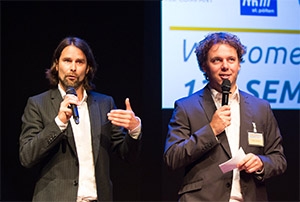
We had the possibility to talk to Conference Chairs Victor de Boer and Tassilo Pellegrini, about the preparations and expectations for this year's SEMANTICS conference.
SEMANTiCS: Our conference is now for the second time in Amsterdam. Looking back to the years between 2017 and today, what has changed since then??
Victor de Boer: When SEMANTiCS came to Amsterdam for the first time in 2017, we were very excited to have the scientific community connect to Dutch and international industry players, as the Netherlands has a rich community of users and providers of semantic technologies. In the past four years, this community has kept on growing, with Knowledge Graphs becoming more and more part of the mainstream. Not only are large industry players integrating such Knowledge Graphs in their digital infrastructure, but also are providers of these technologies now much more established. At the same time, we see that semantics as a research topic is still very popular with researchers across the Netherlands.
Tassilo Pellegrini: While in 2017, the hype around AI was already building steam, its popularity and more important societal impact in the last four years have been even more visible. There is a growing recognition that AI systems need to be more transparent and explainable if they are to be useful and trusted additions to society. There, Knowledge Graphs, in combination with Machine Learning is recognized as a possible solution towards such explainable, transparent and trustworthy AI.
SEMANTiCS: The on-site version of SEMANTiCS made a one-year break because of COVID-19. Now the conference is back on the calendar. What has changed, what is the plan to deal with the new situation in autumn 2021?
Tassilo Pellegrini: With the numbers of vaccinated people rising quickly, we feel confident that in September, we can have a large on-site event. The meeting of people from different backgrounds -industry and research- has always been a unique selling point of SEMANTiCS and we are therefore happy to host people for an actual social conference, with opportunities for discussion and networking and hopefully even shaking hands. Those that cannot attend SEMANTiCS in person due to travel restrictions, will have the opportunity to participate online and get in touch virtually. This hybrid approach is probably a model for the future and allows us to experiment with new formats and audiences.
SEMANTiCS: The Netherlands - and Amsterdam especially - have become a sort of European AI hotspot with a strong legacy in Linked Data and Semantic Technologies. Can you tell us about the local eco-system?
Victor de Boer: In Amsterdam, we have two universities (VU and UvA), a university of applied sciences (HvA), and the Centrum Wiskunde and Informatica (CWI) that all have significant AI and Semantic Web groups. We collaborate with local industry partners and various startups in the Amsterdam Data Science network. Next to this, connections with local governments are resulting in very interesting research and applications of AI and Semantic technologies. And, as you say, it doesn't stop there. In the Netherlands everything is close and the ecosystem extends to -for example- nearby the Hague, with collaborations with national research organization TNO and the national government, with national heritage institutes like National Library. Or to Hilversum, for collaborations with the Netherlands Institute for Sound and Vision. The Dutch Semantic ecosystem is alive and kicking.
SEMANTiCS: You are this year’s conference chair. What can we expect? Where is the journey going?
Tassilo Pellegrini: It is extremely exciting to see how the convergence between formerly separated technology strands, communities, and disciplines is gaining pace with semantic systems at their core. The rapid uptake of semantic technologies over recent years is breathtaking and even for experts, it is difficult to keep pace. Semantics offers the opportunity to witness these developments from the front row - for industry and academia alike, especially when it comes to knowledge graph technologies. Semantics provides a good overview but also dives deeper into the intersections with hot topics such as artificial intelligence, data science, and enterprise data management. So if you want to catch up with the latest trends, leverage your expertise, or simply get started, Semantics is a perfect place to be.